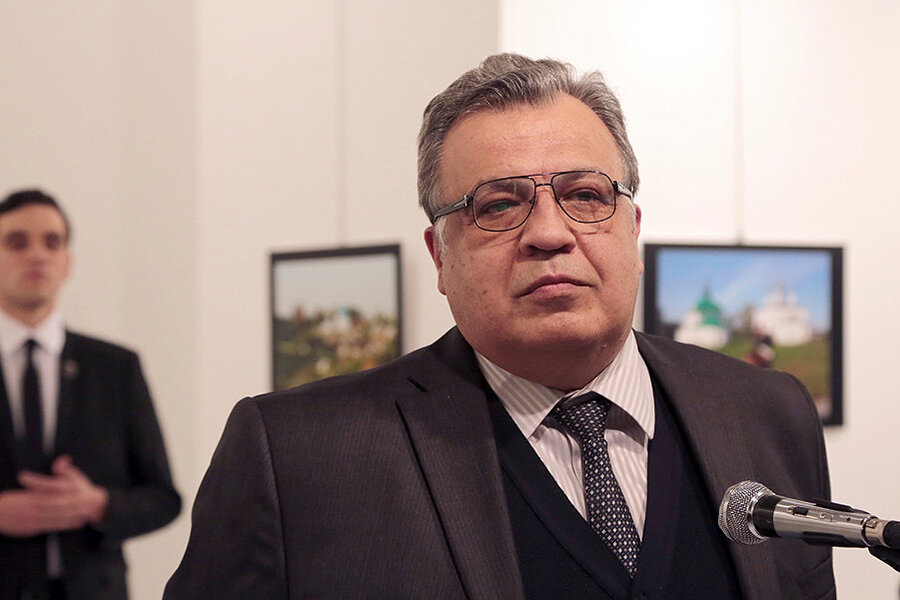How news sites handled graphic photos of Russian ambassador’s murder
Loading...
The photograph appeared on the front page of many major US newspapers: a gunman in suit and tie, mouth caught open mid-declaration, his jaw set in defiance, one hand clutching his weapon and the other jabbing the air. In the background behind him lay the body of his victim, Russia’s ambassador to Turkey.
News of the assassination was alarming enough, given its rarity – thought to be the first killing of a Russian ambassador since the 1920s – as well as its links to the Syrian civil war, which has spun into a proxy conflict involving many of the world’s major powers.
But particularly in the United States, where news outlets mostly chose not to crop the photo to exclude ambassador Andrei Karlov’s body, the image was a story of its own, raising questions about why editors went ahead with such a graphic choice – and perhaps illuminating the subtle ways in which particular national perspectives can color foreign news coverage.
“Why is showing the dead body of the Russian ambassador in Turkey helping me, as a viewer, understand the significance of this act better?” asks Aly Colón, the Knight chair and professor of media ethics at Washington and Lee University, in an interview with The Christian Science Monitor. “That’s in addition to the knowledge you’re bringing to me in a narrative format. And will I understand the circumstances of this assassination better because of it?”
On Monday, after readers wrote to the New York Times to protest its prominent publication of the image on its website, the paper’s public editor Liz Spayd interviewed one of the editors involved in the decision, posing that same question – why not just crop the image?
“That would really undercut the power of the news picture,” said Phil Corbett, a standards and ethics editor for the paper, in the interview. “If the image had been bloody or gruesome, we may have had to consider that option, but we didn’t think it was necessary here.”
“[T]he picture very clearly shows the shocking nature of the attack – much more powerfully, I think, than a mere description in the story itself,” he told the Times. “The well-dressed gunman, the elegant setting – all of this is part of the news value. And while the picture is startling, it’s not gory or sensational in a gratuitous way.”
Several major news outlets based in other countries, including the BBC and the Guardian, did crop out the ambassador’s body, partly or in full.
“My guess is if it were an American, the probability we’d see him lying on the ground there would be a lot lower,” says Matthew Baum, a professor of global communications and public policy at Harvard University’s Kennedy School.
When it comes to slain American servicemembers, at least, the US-based press is reluctant to publish images, even during wartime. One 2005 survey by the Los Angeles Times of six prominent US newspapers and two popular newsweeklies found that in a six-month period of the Iraq war in which 559 Americans and Western allies died, almost no photographs of Americans killed in combat were published.
“This is a function, as much as anything, of political incentives and profit motives,” Dr. Baum tells the Monitor. “When the US is involved in a conflict overseas and those sorts of images are shown, major media networks get an awful lot of negative pushback from Congress, the White House and also from viewers.”
Some journalists who reported details of Americans killed during the Iraq war received death threats, Baum says.
Strong reader feedback “generates not just political pressure, but economic pressure,” he adds. “If readers don’t like it, they watch something else. Those sorts of motives are not unique to the US, but they tend to be more extreme.”
For US editors, the choice to show the ambassador’s killing in such a dramatic way may have been informed by the geopolitical implications, with Russia’s recent supplanting of the US as Syria’s main power broker.
Callous as it might seem to point out, wrote Bloomberg columnist Leonid Bershidsky on Tuesday, the assassination of Mr. Karlov might be traced to Russia’s assertiveness in Syria – for many Americans, an old quandary.
“Ambassadors are assassinated because they represent their countries, and they don't do it in the same abstract way as innocent victims of attacks like the one in Berlin on Monday night,” wrote Mr. Berhidsky. “That sets them up as targets for those who want to make a statement against those policies.”
Still, the decision to show Karlov and his assassin may boil down to something as simple as the men's nationalities.
"Maybe that's the answer: on one hand, it doesn't involve Americans, so you won't necessarily have the pushback," Baum says.








